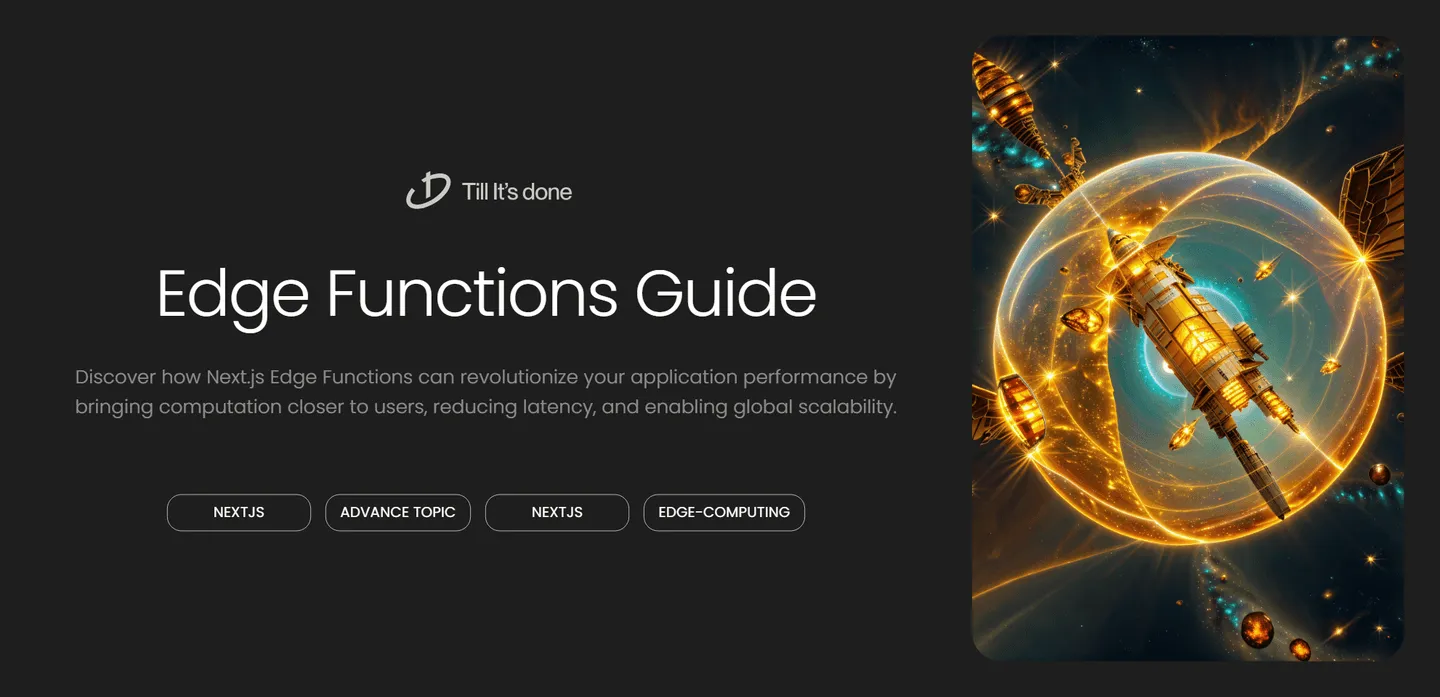- Services
- Case Studies
- Technologies
- NextJs development
- Flutter development
- NodeJs development
- ReactJs development
- About
- Contact
- Tools
- Blogs
- FAQ
Using Next.js Edge Functions: Speed Up Your Apps

Using Next.js Edge Functions for Low-Latency Applications

In today’s digital landscape, user experience is paramount, and latency can make or break an application. Enter Next.js Edge Functions – a game-changing feature that brings computation closer to your users, dramatically reducing response times and enhancing application performance.
What Are Edge Functions?
Edge Functions allow you to execute server-side code at the edge of the network, as close to your users as possible. Unlike traditional server deployments where code runs in a centralized location, Edge Functions operate on a distributed network of servers worldwide, minimizing the physical distance data needs to travel.

Key Benefits of Edge Functions
Lightning-Fast Response Times
By running code at the edge, you can reduce latency from hundreds of milliseconds to mere microseconds. This is particularly crucial for features like real-time data processing, authentication, and personalization.
Global Scalability
Edge Functions automatically scale based on demand and are deployed globally, ensuring consistent performance regardless of user location. Your application maintains responsiveness even during traffic spikes.
Cost-Effective Architecture
Since Edge Functions only run when needed and scale automatically, you only pay for what you use. This makes them an economically viable solution for both small startups and large enterprises.
Implementing Edge Functions in Next.js
Let’s explore how to implement Edge Functions for common use cases:
1. Geolocation-Based Content Delivery
export const config = { runtime: 'edge'};
export default async function handler(req) { const country = req.headers.get('x-vercel-ip-country');
return new Response(JSON.stringify({ content: getLocalizedContent(country) }), { headers: { 'content-type': 'application/json' } });}2. Real-Time Data Processing
export const config = { runtime: 'edge'};
export default async function handler(req) { const data = await req.json(); const processedData = await processStreamingData(data);
return new Response(JSON.stringify(processedData), { headers: { 'content-type': 'application/json' } });}
Best Practices and Considerations
When implementing Edge Functions, keep these guidelines in mind:
- Keep functions lightweight and focused
- Implement proper error handling
- Use appropriate caching strategies
- Monitor performance metrics
- Consider data residency requirements
Remember that Edge Functions are best suited for operations that require low latency and don’t need access to a traditional database. For complex database operations, you might want to consider combining Edge Functions with other serverless solutions.
Conclusion
Next.js Edge Functions represent a significant step forward in building high-performance web applications. By bringing computation closer to users, they enable developers to create responsive, scalable applications that meet modern performance requirements.
Whether you’re building a global e-commerce platform, a real-time analytics dashboard, or a content delivery system, Edge Functions provide the tools needed to deliver exceptional user experiences with minimal latency.

 สร้างเว็บไซต์ 1 เว็บ ต้องใช้งบเท่าไหร่? เจาะลึกทุกองค์ประกอบ website development cost อยากสร้างเว็บไซต์แต่ไม่มั่นใจในเรื่องของงบประมาณ อ่านสรุปเจาะลึกตั้งแต่ดีไซน์, ฟังก์ชัน และการดูแล พร้อมตัวอย่างงบจริงจาก Till it’s done ที่แผนชัด งบไม่บานปลายแน่นอน
สร้างเว็บไซต์ 1 เว็บ ต้องใช้งบเท่าไหร่? เจาะลึกทุกองค์ประกอบ website development cost อยากสร้างเว็บไซต์แต่ไม่มั่นใจในเรื่องของงบประมาณ อ่านสรุปเจาะลึกตั้งแต่ดีไซน์, ฟังก์ชัน และการดูแล พร้อมตัวอย่างงบจริงจาก Till it’s done ที่แผนชัด งบไม่บานปลายแน่นอน  Next.js สอน 14 ขั้นตอนเบื้องต้น: สร้างโปรเจกต์แรกใน 30 นาที เริ่มต้นกับ Next.js ใน 14 ขั้นตอนเพียงแค่ 30 นาที พร้อม SSR/SSG และ API Routes ด้วยตัวอย่างโค้ดง่าย ๆ อ่านต่อเพื่อสร้างโปรเจ็กต์แรกได้ทันทีที่นี่
Next.js สอน 14 ขั้นตอนเบื้องต้น: สร้างโปรเจกต์แรกใน 30 นาที เริ่มต้นกับ Next.js ใน 14 ขั้นตอนเพียงแค่ 30 นาที พร้อม SSR/SSG และ API Routes ด้วยตัวอย่างโค้ดง่าย ๆ อ่านต่อเพื่อสร้างโปรเจ็กต์แรกได้ทันทีที่นี่  วิธีสมัคร Apple Developer Account เพื่อนำแอปขึ้น App Store ทีละขั้นตอน อยากปล่อยแอปบน App Store ระดับโลก มาอ่านคู่มือสมัคร Apple Developer Account พร้อมเคล็ดลับ TestFlight และวิธีอัปโหลดที่ง่ายในบทความเดียวนี้ได้เลย
วิธีสมัคร Apple Developer Account เพื่อนำแอปขึ้น App Store ทีละขั้นตอน อยากปล่อยแอปบน App Store ระดับโลก มาอ่านคู่มือสมัคร Apple Developer Account พร้อมเคล็ดลับ TestFlight และวิธีอัปโหลดที่ง่ายในบทความเดียวนี้ได้เลย  TypeScript Interface คืออะไร? อธิบายพร้อมวิธีใช้และข้อแตกต่างจาก Type เรียนรู้วิธีใช้ TypeScript Interface เพื่อสร้างโครงสร้างข้อมูลที่ปลอดภัยและเข้าใจง่าย พร้อมเปรียบเทียบข้อดีข้อแตกต่างกับ Type ที่คุณต้องรู้ ถูกรวมเอาไว้ในบทความนี้แล้ว
TypeScript Interface คืออะไร? อธิบายพร้อมวิธีใช้และข้อแตกต่างจาก Type เรียนรู้วิธีใช้ TypeScript Interface เพื่อสร้างโครงสร้างข้อมูลที่ปลอดภัยและเข้าใจง่าย พร้อมเปรียบเทียบข้อดีข้อแตกต่างกับ Type ที่คุณต้องรู้ ถูกรวมเอาไว้ในบทความนี้แล้ว  Material-UI (MUI) คืออะไร อยากสร้าง UI สวยงามและเป็นมืออาชีพในเวลาอันรวดเร็วใช่ไหม มาทำความรู้จักกับ Material-UI (MUI) ที่ช่วยให้คุณพัฒนาแอปพลิเคชันบน React ได้ง่ายและดูดีในทุกอุปกรณ์
Material-UI (MUI) คืออะไร อยากสร้าง UI สวยงามและเป็นมืออาชีพในเวลาอันรวดเร็วใช่ไหม มาทำความรู้จักกับ Material-UI (MUI) ที่ช่วยให้คุณพัฒนาแอปพลิเคชันบน React ได้ง่ายและดูดีในทุกอุปกรณ์  เปรียบเทียบ 3 วิธีติดตั้ง install node js บน Ubuntu: NVM vs NodeSource vs Official Repo แบบไหนดีที่สุด? เรียนรู้วิธีติดตั้ง Node.js บน Ubuntu ด้วย NVM, NodeSource หรือ Official Repo เลือกวิธีที่เหมาะกับความต้องการของคุณ พร้อมเปรียบเทียบ เพื่อการพัฒนาที่มีประสิทธิภาพ!
เปรียบเทียบ 3 วิธีติดตั้ง install node js บน Ubuntu: NVM vs NodeSource vs Official Repo แบบไหนดีที่สุด? เรียนรู้วิธีติดตั้ง Node.js บน Ubuntu ด้วย NVM, NodeSource หรือ Official Repo เลือกวิธีที่เหมาะกับความต้องการของคุณ พร้อมเปรียบเทียบ เพื่อการพัฒนาที่มีประสิทธิภาพ! Talk with CEO
We'll be right here with you every step of the way.
We'll be here, prepared to commence this promising collaboration.
Whether you're curious about features, warranties, or shopping policies, we provide comprehensive answers to assist you.


